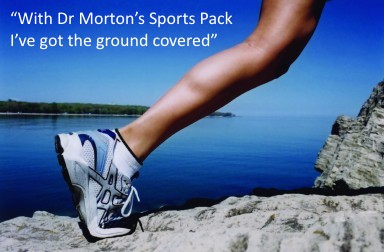Protect ligaments and joints

Whether dealing with a ligament or joint injury, or a long-term joint disease such as rheumatoid arthritis, expert help can be invaluable
- help repair ligaments as fast as possible
- protect your joints from further injury
- use pain relief and strapping where suitable
With Dr Morton’s - the medical helpline© you can email or phone a real doctor at any time for more information, reassurance or advice
Dr Morton's Sports Injury Pack©
Repair ligaments to protect your joints
Ligaments run from one bone to another bone supporting the joint in between, so are essential for good joint function. Ligaments have poor blood supply, so are slow to heal. Ligaments may be sprained or torn; either way it takes months for them to heal properly, but their full repair is vital to protect the joints they cross. Ligaments may even form part of the capsule of the joint. Common ligaments to injure are
- ankle ligaments in an ankle sprain
- knee ligaments, such as the lateral collateral ligament of the knee (LCL), medial collateral ligament of the knee (MCL), or anterior cruciate ligament of the knee (ACL)
- ligaments in the back
- shoulder ligaments tear in shoulder dislocation (Mark Cavendish in the 2014 Tour de France)
- ulnar collateral ligament of the elbow
- wrist ligaments
Ligaments may be naturally over-stretchy, such as in hypermobility syndrome, where you need to learn how to control the excessive movement of the joints to avoid injury. Since ligaments are visco-elastic, they change shape with tension as a joint moves. If a joint moves excessively, such as in a joint dislocation, reduction of the dislocation as soon as possible is important to allow the ligament to retain its normal shape, or recovery will be prolonged.
Joints are the key to our flexibility and functioning. Joints may be damaged inside as in osteoarthritis where the cartilage is damaged, or in rheumatoid arthritis (RA) where there may be joint swelling due to inflammation. RA pain can cause sore or aching joints but these symptoms are also commonly seen in a variety of other problems including excessive stress on the joints and viral infections, or can occur in association with conditions such as psoriasis or colitis.
Symptoms of joint or ligament injury may be
- pain in or around the joint eg shoulder pain
- swelling of the joint or nearby soft tissue
- restriction of movement of the joint
When you should contact a doctor
You should contact a doctor if you are unable to weight bear on a joint, the joint is restricted in its range of movement, or there is any evidence of deformity.
Available treatments
Initial treatment would be PRICE
- P for protection (from further damage)
- R for rest
- I for ice
- C for compression
- E for elevation
Pain relief and strapping the injury are also very important. Invaluable information and help are to be found in

